Related Research Articles

Balanus is a genus of barnacles in the family Balanidae of the subphylum Crustacea.

Thoracica is an infraclass of crustaceans which contains the most familiar species of barnacles found on rocky coasts, such as Semibalanus balanoides and Chthamalus stellatus. They have six well-developed limbs, and may be either stalked or sessile. The carapace is heavily calcified. The group includes free-living and commensal species.

Thecostraca is a class of marine invertebrates containing over 2,200 described species. Many species have planktonic larvae which become sessile or parasitic as adults.

The Balanidae comprise a family of barnacles of the order Balanomorpha. As a result of research published in 2021 by Chan et al., the members of the family Archaeobalanidae were merged with this family.

The Balanomorpha are an order of barnacles, containing familiar acorn barnacles of the seashore. The order contains these families:

Whale barnacles are species of acorn barnacle that belong to the family Coronulidae. They typically attach to baleen whales, and sometimes settle on toothed whales. The whale barnacles diverged from the turtle barnacles about three million years ago.
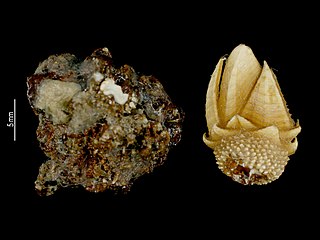
Calanticidae is a family of acorn barnacles in the order Calanticomorpha. There are about 12 genera and more than 60 described species in Calanticidae.

The Chthamaloidea are a subdivision of Balanomorpha proposed by Newman and Ross to include barnacles with shell wall composed of rostrum, carina, and one to three pairs of latera, rarely supplemented with one or more whorls of basal imbricating plates. The rostrolatus enters the sheath, but rarely fuses with the rostrum, as in the three higher superfamilies. Shell plates are simple in construction, solid, and incorporate organic chitin between carbonate layers. Opercular plates are deeply interlocked, and in some genera, may become concrescent with age. Soft part morphology includes concave labrum without notch in the central part. Cirrus III more resembles Cirrus IV than II, or may be intermediate in structure. Caudal appendages present in some species.
The Catophragmidae are a family of barnacles in the superfamily Chthamaloidea with eight shell wall plates, surrounded by several whorls of imbricating plates. The basis is membranous.
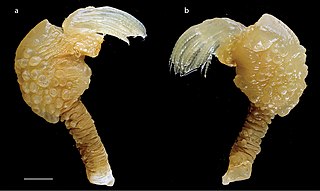
Paralepas is a genus of goose barnacles in the family Heteralepadidae.

Poecilasmatidae is a family of goose barnacles.

The clade Multicrustacea constitutes the largest superclass of crustaceans, containing approximately four-fifths of all described crustacean species, including crabs, lobsters, crayfish, shrimp, krill, prawns, woodlice, barnacles, copepods, amphipods, mantis shrimp and others. The largest branch of multicrustacea is the class Malacostraca.

Scalpellidae is a family of acorn barnacles in the order Scalpellomorpha. There are about 25 genera and 220 described species in Scalpellidae.

Pyrgomatidae is a family of barnacles belonging to the order Balanomorpha.
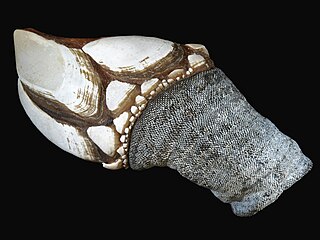
Scalpellomorpha is an order of acorn barnacles in the class Thecostraca. There are about 11 families in 3 superfamilies and more than 450 described species in Scalpellomorpha.
Iblomorpha is a small order of barnacles in the class Thecostraca. There are only two families and about eight described species in Iblomorpha.

Calanticomorpha is an order of acorn barnacles in the class Thecostraca. There are 3 families and more than 90 described species in Calanticomorpha.
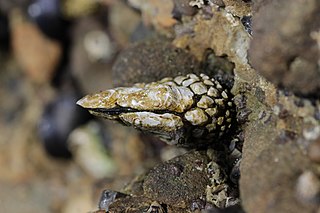
Pollicipedomorpha is an order of pedunculated barnacles in the class Thecostraca. There are 3 families and more than 30 described species in Pollicipedomorpha.

Verrucomorpha is an order of asymmetrical sessile barnacles in the class Thecostraca. They are typically found in deeper and deep-sea habitats. There are 2 families and more than 100 described species in Verrucomorpha.
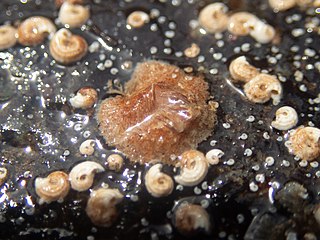
Verruca is a genus of asymmetrical sessile barnacles in the family Verrucidae. There are about 20 described species in Verruca, around half of them extinct.
References
- ↑ Chan, Benny K. K.; Dreyer, Niklas; Gale, Andy S.; Glenner, Henrik; et al. (2021). "The evolutionary diversity of barnacles, with an updated classification of fossil and living forms". Zoological Journal of the Linnean Society. 193 (3): 789–846. doi: 10.1093/zoolinnean/zlaa160 .
- ↑ "World Register of Marine Species, subclass Cirripedia" . Retrieved 2021-08-22.